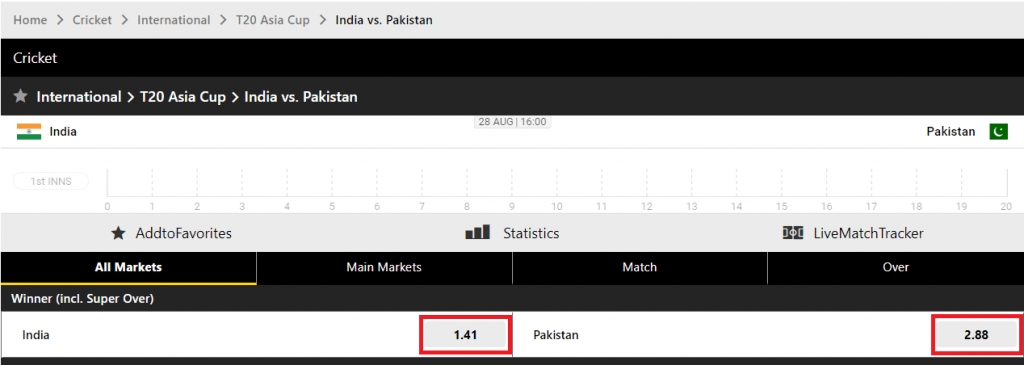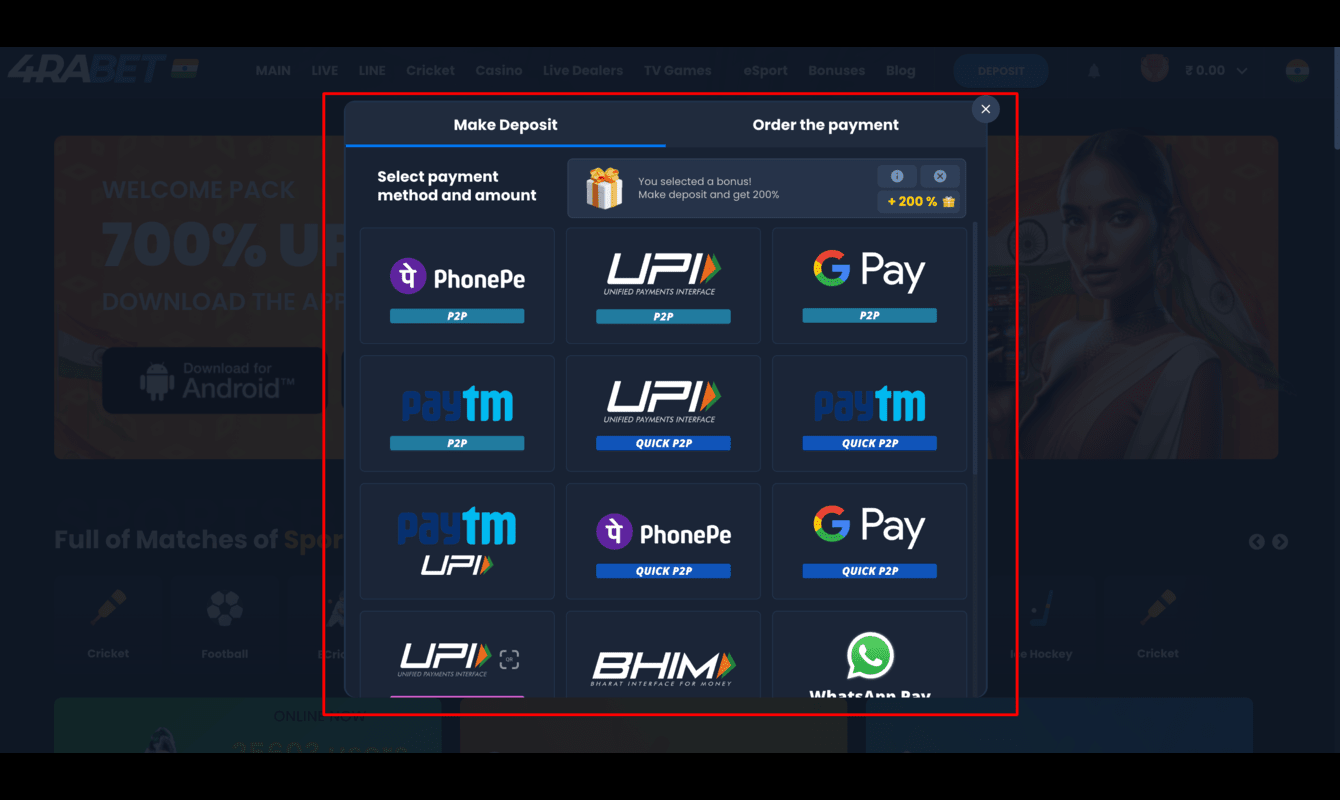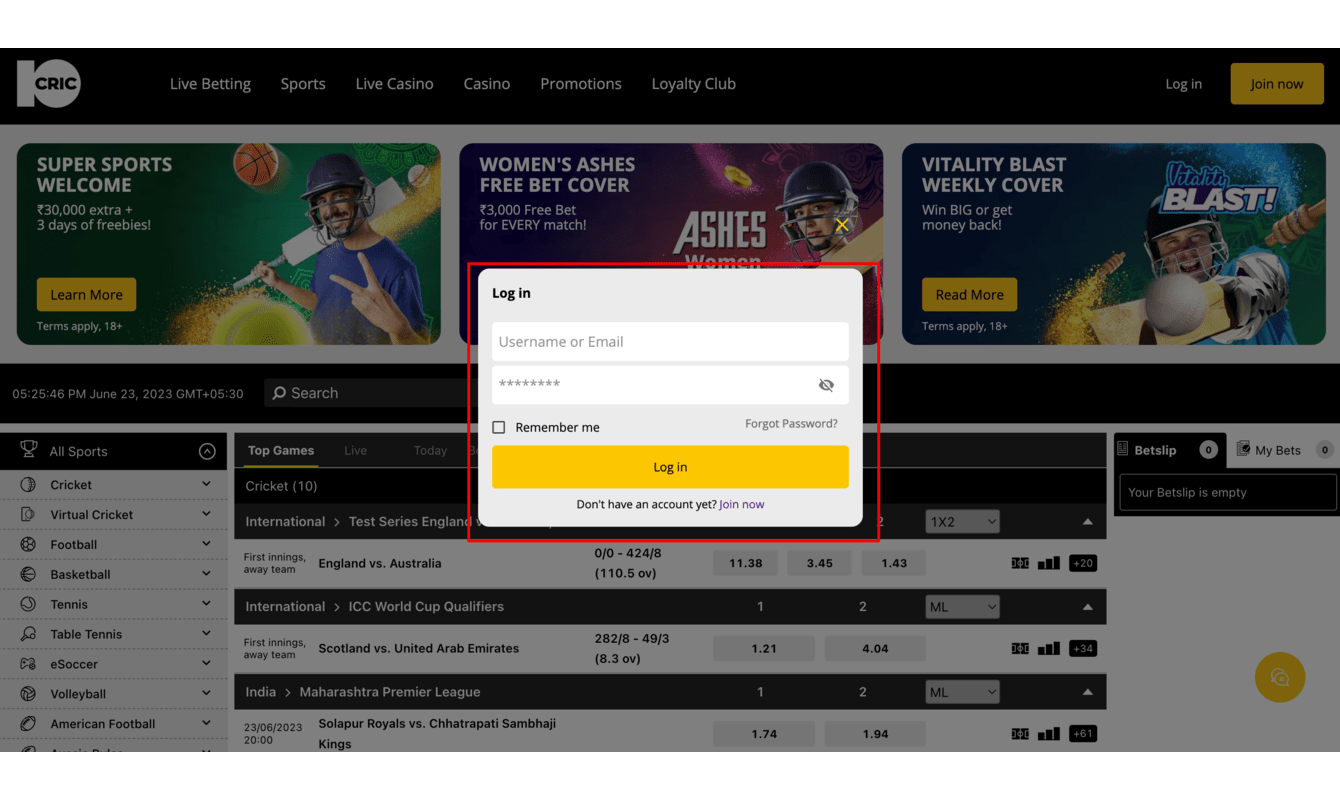What Are Betting Odds? Detailed Guide for Beginners

Does reading and understanding betting odds an issue for you?
Don’t worry, our comprehensive guide will show you how to read betting odds and calculate probability.
We’ll also compare different types of odds and answer the most important questions.
So, let’s jump into the topic!
Sportsbooks With the Best Betting Odds
What Are Betting Odds?
Since you’re here, you’re probably wondering, “What are odds and why do I need them?”
Bookmakers create betting odds to show what they believe the probability of an event or a series of events occurring is.
Odds can be represented as:
- Decimal (2.00), most commonly used in India and Europe,
- Fraction (3/1), used in the UK and some parts of Europe
- American odds (+200), used in the US
Let’s say you want to bet on the Bengaluru Blasters vs Gulbarga Mystics T20 Maharaja Trophy Match.

The odds set by the bookmakers (in this case 10Cric), will show you how likely the sportsbook believes the Bengaluru Blasters will win.
Any event bookies accept bets on, including cricket, IPL, horse racing, football, greyhound racing, TV specials, and politics, will have betting odds.
How to Change the Display of Odds
As we mentioned, decimal odds are the most common betting odds in India, but you can bet using other types if you want to.
Practically every betting site will allow you to change the display of odds to your preferred type. And it’s easy to do so.
Now, every betting site will have this option placed in a different part of the site, but it’s typically in the top or side bars.
How to Change the Display of Odds on 22Bet
It’s practically the same on 22Bet, too.

The option to change the odds display is in the main top bar, where the American style is marked as “US,” the fractional odds are marked as “UK.”
Moreover, you can also choose the Hong Kong, Indonesian, and Malaysian types of odds.
We won’t review the last three types of odds in this article.
However, you can read more about 22Bet odds of different sports in our 22Bet sportsbook review.
How to Read Betting Odds
As we mentioned, virtually all sportsbooks offer three main types of odds — decimal, fractional, and American.
Of course, there are other types of odds, too (Malaysian, for example), but we’ll stick to these three, explain them in detail, and show you how to read them.
However, before we get into the matter, you should know that these are just different ways of displaying the odds.
They refer to the format, meaning the payout is still the same even though they’re represented through different formats and numbers.
Decimal Betting Odds
Decimal odds are the easiest to read and understand, and you can spot the favourites and underdogs right away.
The decimal odds number shows the amount won for each rupee wagered.
Numbers with decimal odds represent total payout rather than profit.
In other words, it is easier to calculate the total payment because your stake is already included in the decimal amount (you don’t need to add it back).
To calculate the decimal odds, simply multiply the amount you intend to wager by the decimal odds displayed, and you will have your payout.
You can represent this through a simple formula:
Stake x Odds = Total Payout
Let’s see an example so that this becomes more clear.

As we can see, 10Cric offers 1.41 odds for India and 2.88 odds for Pakistan.
We can see that India is the favourite here, while Pakistan is the underdog.
Say you want to bet ₹100 on India. In case you win, your total payout would be ₹141, since
₹100 x 1.41 = ₹141
Since you’d wager ₹100, your winnings would be ₹41 in this case.
However, let’s say you want to place a bet on the underdog — Pakistan.
The risk is bigger, but so is the potential reward.
We’ll apply the same formula:
₹100 x 2.88 = ₹288
The total payout would be ₹288, but since you wagered ₹100, your actual winnings would be ₹188.
American Betting Odds
American odds are a bit more complicated. As the name suggests, they’re mostly used in the States.
When it comes to American cricket betting odds, the favourite is represented with a minus sign (-).
The minus sign in front of the odds for the favourite shows the amount you need to wager to win ₹100.
On the other hand, the underdog is represented with a plus sign (+).
The plus sign in front of the odds for the underdog indicates the amount you can win for every ₹100 you bet.
The formula for calculating the payout and winnings will depend on whether you want to bet on the favourite or the underdog.
For the favourite (-):
(100/Odds) x Stake = Winnings
For the underdog (+):
(Stake/100) x Odds = Winnings
Please note that you’ll always be calculating the winnings, not the total payout with American odds.
You must add the stake to the winning amount to get your total payout.
Confused?
We understand, so let’s see it as an example. Let’s see Betway’s odds for the England vs. South Africa Test Match.

As you can see, England’s odds are represented with a minus sign, so they are the favourite, while South Africa is the underdog, and the odds are expressed with a plus sign.
If you want to bet ₹100 on the favourite, England, the formula would be:
(100/800) x ₹100 = ₹12,5
Add the ₹100 stake to that, and your total payout would be ₹125.
Now, if you want to bet on South Africa, the underdog, your potential winnings would look like this:
(₹100/100) x 450 = ₹450
Add the original ₹100 bet, and your total payout would be ₹550.
Fractional Betting Odds
Fractional betting odds are the most complicated of the three, but we’ll explain and simplify them like the previous two types.
This type of odds is mostly used in the UK and some parts of Europe.
They’re usually represented with a slash (/) or a hyphen (-). You’ll probably encounter both, but don’t worry, both are correct.
The fractional system uses ratios or fractions to express odds.
While the underdog will have a numerator (first number) greater than the denominator, the favourite will have a denominator (second number) greater than the first.
It is common to refer to an even-money wager simply as “even” because it is expressed as a 1/1 ratio.
Other varieties of fractional odds are pronounced as:
- 3/1 — “Three-to-one” refers to an underdog
- 1/2 — “One-to-two” refers to a favourite
Just like in the American system, the odds determine the winnings, not the total payout.
You’ll have to add the original bet to your profit amount to get the total payout.
You can calculate your potential profit easily with the following formula:
Amount Wagered x Odds = Profit
Let’s simplify this with an example. Here we have the fractional odds for Australia vs Zimbabwe One Day Internationals match.

As we can see, Australia is the favourite with 1/50 odds, while Zimbabwe is the underdog with 11/1 odds.
So, if you bet ₹100 on the Australian team, you can calculate your potential profit this way:
₹100 x 1/50 = ₹2
Add the ₹100 from the original bet, and your total payout would be ₹102.
However, your potential payout would be higher if you decide to bet on the underdog.
Let’s use the same formula again to calculate it.
₹100 x 11/1 = ₹1,100
You would win ₹1,100, but if we add the ₹100 you have wagered, your total payout would be ₹1,200.
Comparing Different Types of Odds
Now that we’ve explained cricket betting odds let’s see how all three types would look for one match.
Let’s see Betway’s odds for the Kenya vs. Nepal T20 International match.

As we can see from the decimal odds, Kenya is the underdog with 3.25 odds, while Nepal is the clear favourite with 1.28 odds.
Applying the above mentioned formula, betting ₹100 on the underdog would bring you a total payout of ₹325.
On the other hand, betting the same amount on the favourite would bring you a total of ₹128.

If we convert this to American odds, we’ll get +225 odds for Kenya, and -350 for Nepal.
Applying the American odds formulas, we’ll get the same results:
(₹100/100) x 225 = ₹225
Add the original ₹100 wager, and your total payout is ₹325.
The same goes for the favourite:
(100/1.28) x ₹100 = ₹28
Don’t forget to add your ₹100 wager to the winnings, and you’ll get a ₹128 total payout.
The same goes for the fractional odds.

With Kenya having 9/4 and Nepal 2/7 odds, wagering ₹100 would give you the same ₹325 for the underdog and ₹128 for the favourite.
Let’s use the formula to prove it:
₹100 x 9/4 = ₹225
If we add the ₹100 you wagered initially, we get ₹325 total profit for betting on the underdog.
On the other hand:
₹100 x 2/7 = ₹28
With the ₹100 you have wagered, that would give you a total payout of ₹128 for the favourite.
What Is Implied Probability?
If you’ve visited some online sportsbooks, you’ve probably seen the term “implied probability.”
Implied probability is the likelihood of an event happening, and it’s expressed in percentages.
You can use odds, all three types, to calculate the probability of your chosen team winning the match.
Let’s see how.
How to Calculate Implied Probability
An online betting odds calculator can help you with this calculation, but it would probably be faster to use the formulas we’re about to show you and do it manually.
Calculating Implied Probability With Decimal Odds
The formula you need to use to calculate implied probability with decimal odds is:
(1/ Decimal Odds) x 100 = Implied Probability
We’ll illustrate this with an example from the decimal betting odds section.
As we’ve seen, India has 1.41 odds while Pakistan has 2.88.
When we apply the formula, we’ll see that:
(1/ 1.41) x 100 = 70.92
and
(1/ 2.88) x 100 = 34.72
According to these calculations, India has 70.92% implied probability, while Pakistan has 24.72%.
Calculating Implied Probability With American Odds
We again have two formulas, just like for calculating the odds. So, the formula for calculating the probability for the favourite would be:
(Negative American Odds + 100) x 100 = Implied Probability
While the formula for the underdog would be:
(Positive American Odds + 100) x 100 = Implied Probability
Let’s apply these formulas to the example from the American betting odds section.
We already know that England has the odds of -800, while South Africa has +450.
(-800 + 100) x 100 = 88.89
and
(+450 + 100) x 100 = 18.18
This means England has 88.89% and South Africa has 18.18% implied probability.
Calculating Implied Probability With Fractional Odds
Lastly, let’s see how you can calculate the implied probability with fractional odds.
We’ll again use a familiar example, the Australia vs. Zimbabwe match from the fractional odds section.
We already know the odds: 1/50 for Australia and 11/1 for Zimbabwe.
The formula for calculating the implied probability with fractional odds is:
Denominator / (Denominator + Numerator) x 100 = Implied Probability
This means the equation would look like:
50 / (50 + 1) x 100 = 98.04 for the favourite
and
1 / (1 + 11) x 100 = 8.33 for the underdog
This means Australia’s implied probability is 98.04%, while Zimbabwe has an 8.33% implied probability.
Why Do Betting Odds Change?
Profit is the single factor that motivates bookmakers to change their odds.
In any game, each outcome has a 50% likelihood of happening. However, bookmakers do not need an equal number of wagers on both sides of the action.
Bookmakers ensure that they make a profit regardless of which side eventually wins by tipping the action on one side depending on a number of factors.
These factors may include news on injuries, team selection, and similar.
Try Our Recommended Sportsbooks
FAQs
What is the difference between odds and probability?
Probability is a statistical concept that expresses the possibility of an event happening.
Additionally, odds also indicate the possibility of an event (its probability). But in addition to that, they also show the potential financial benefit that might result from the event.
Why do different sportsbooks offer different odds?
When a betting site sets the odds, the bookmaker considers both likelihood and profit (margin). The odds can fluctuate depending on the margin coefficients used by different sportsbooks.
Why would you bet on negative odds?
Negative odds indicate a strong likelihood of winning the bet. But keep in mind that the winnings are small. Therefore, placing a wager with negative odds can be a smart move for bettors who choose to minimize risk over maximum reward.












